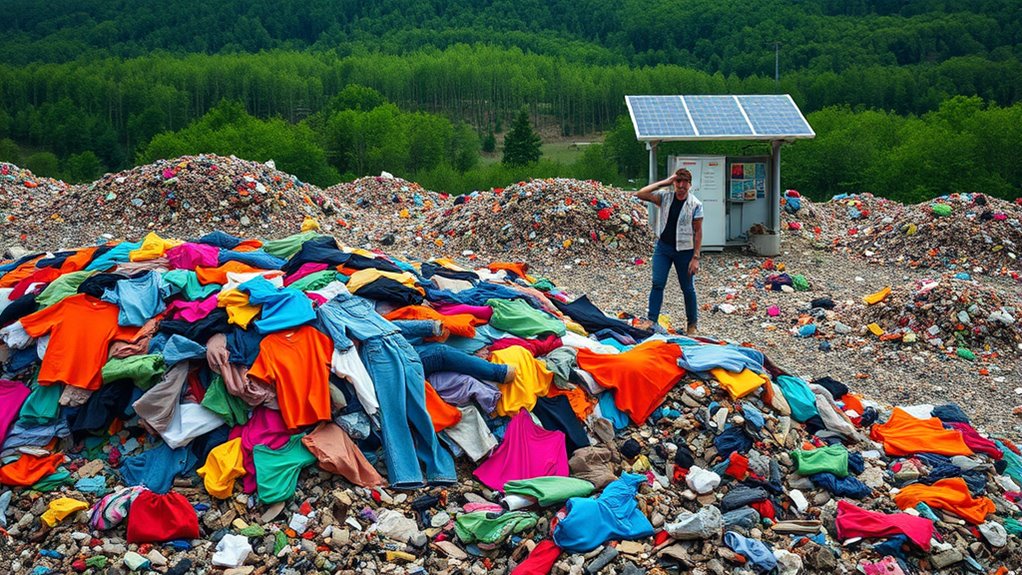Fashion impacts the environment through excessive water use, pollution, greenhouse gas emissions, and waste from fast fashion. By choosing sustainable materials, buying fewer high-quality clothes, and supporting eco-conscious brands, you can reduce your footprint. Proper care and recycling clothes help extend their lifespan and cut waste. Embracing innovative technologies and ethical practices makes the fashion industry more sustainable. Keep exploring how your choices can make a difference with simple actions that add up.
Key Takeaways
- Fast fashion accelerates waste, pollution, and greenhouse gas emissions, significantly harming ecosystems and contributing to climate change.
- Water-intensive production and toxic chemical use in textile manufacturing contaminate water sources and threaten aquatic life.
- Choosing sustainable materials, recycling fabrics, and supporting ethical brands reduce environmental impact and promote eco-friendly practices.
- Extending garment lifespan through quality, proper care, and secondhand shopping minimizes waste and resource consumption.
- Technological innovations like waterless dyeing and bio-fabrication can significantly lower fashion industry environmental footprints.
The Environmental Footprint of Fast Fashion
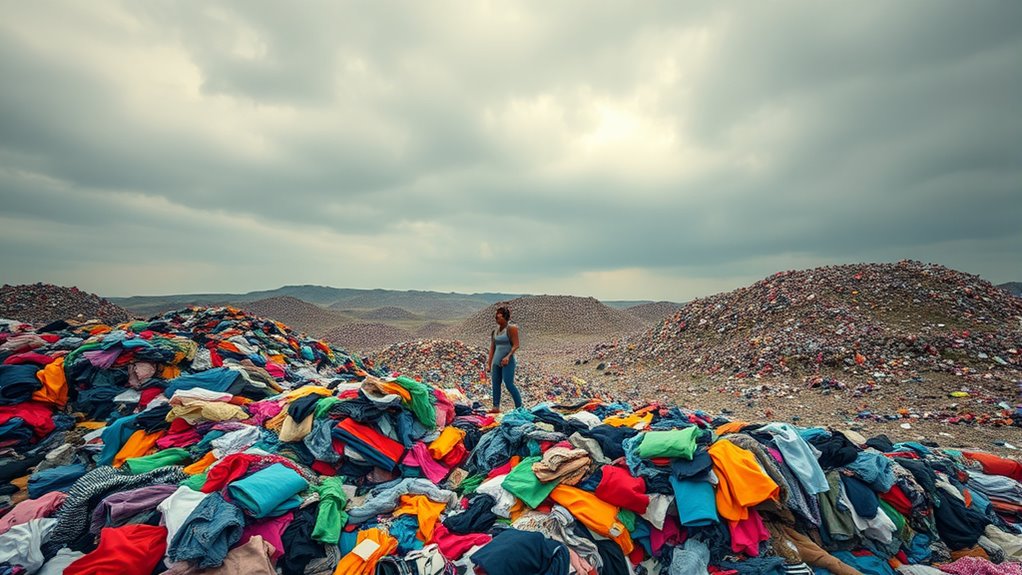
Fast fashion substantially contributes to environmental degradation because it encourages rapid production and consumption of cheap clothing. When you buy fast fashion, you support a system designed to churn out new styles quickly, often at the expense of the environment. This cycle leads to increased waste, as garments are discarded after only a few wears. The production process consumes vast amounts of resources, including energy and raw materials, which adds to pollution and greenhouse gas emissions. Fast fashion brands prioritize speed and low costs over sustainability, resulting in harmful practices like overproduction and surplus waste. As a consumer, your choices directly impact this cycle, making it vital to consider the environmental costs behind each inexpensive garment you purchase. Additionally, many fast fashion items are made from synthetic fibers that do not biodegrade, further exacerbating environmental harm from synthetic fabrics. Recognizing the environmental impact of these materials can motivate more sustainable choices and support eco-friendly alternatives. Implementing mindful purchasing habits can significantly reduce your clothing waste footprint and promote a more sustainable fashion industry. Moreover, exploring sustainable fashion options can help reduce reliance on environmentally damaging practices. Being aware of the supply chain involved in clothing production can also encourage more responsible consumer behavior.
Water Consumption and Pollution in Textile Production
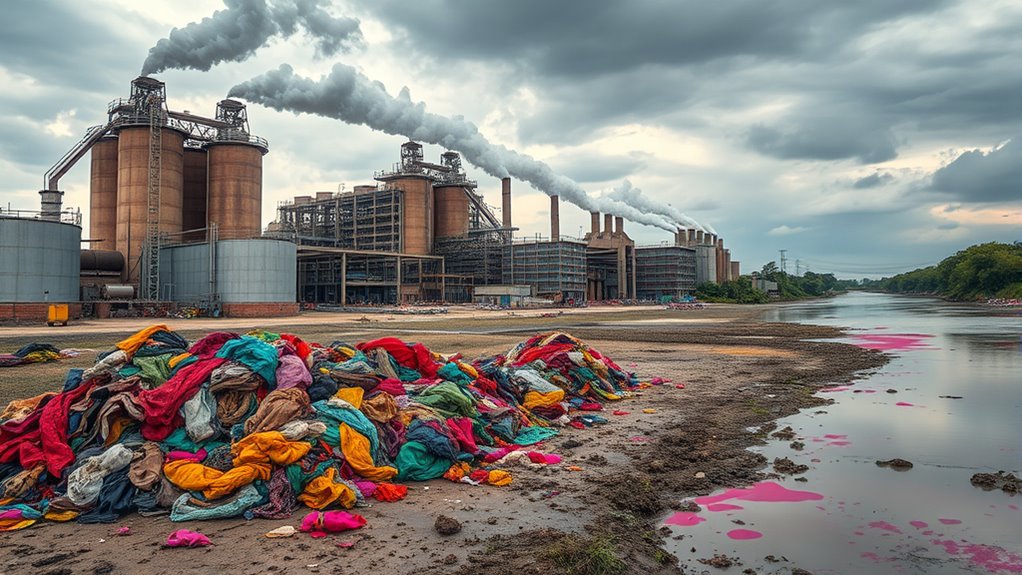
Textile production is a major water consumer and polluter, with significant environmental impacts that often go unnoticed. You might not realize that producing a single cotton shirt requires thousands of liters of water, much of it wasted or contaminated. Water is used for growing fibers, dyeing fabrics, and finishing materials, often in regions with limited water resources. This process releases pollutants like dyes, chemicals, and heavy metals into nearby water bodies, harming ecosystems and communities. Additionally, patterns of behavior in the fashion industry may perpetuate unsustainable practices, making it essential for consumers to advocate for change. Recognizing the importance of water conservation in manufacturing can encourage brands to adopt more sustainable methods. Implementing water-efficient technologies can significantly reduce water usage in textile factories. If you’re concerned about your fashion choices, consider supporting brands that use water-efficient methods or organic fibers. Reducing water-intensive production and advocating for cleaner practices can help lessen your fashion’s environmental footprint. Every small step counts toward protecting essential water resources.
The Impact of Chemical Use in Clothing Manufacturing
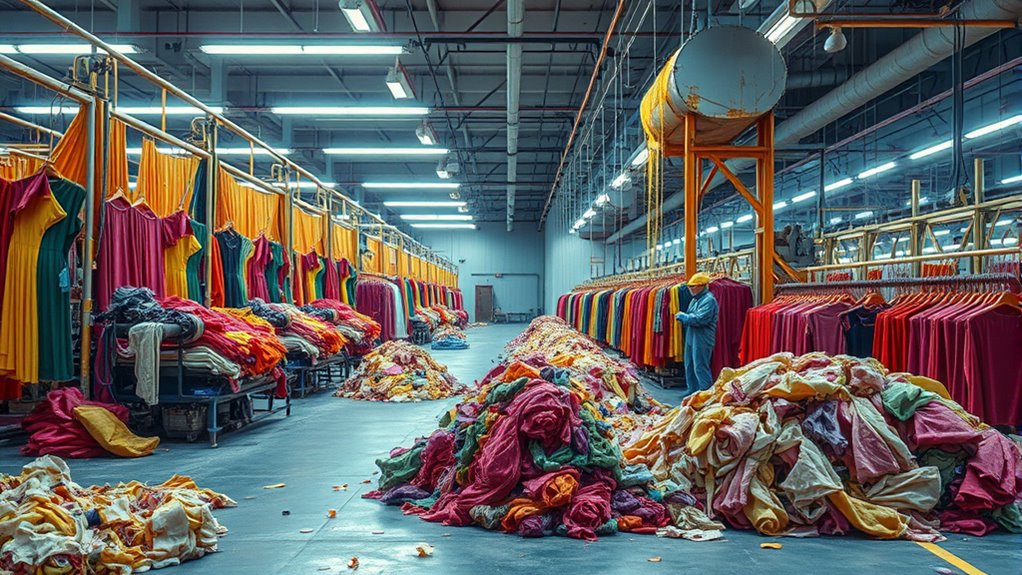
While chemical use is essential for producing vibrant and durable clothing, it often comes with serious environmental and health risks. Chemicals like formaldehyde, dyes, and pesticides contaminate water sources, harm ecosystems, and expose workers and consumers to toxic substances. These substances can cause skin irritations, respiratory issues, and long-term health problems. Additionally, many chemicals are not biodegradable, lingering in the environment for years. For instance, recycled materials can sometimes be processed with fewer harmful chemicals, reducing their environmental footprint. Implementing sustainable manufacturing processes can significantly decrease the reliance on hazardous chemicals and lessen environmental impact. Recognizing the economic impact of chemical pollution encourages manufacturers to adopt greener alternatives. Furthermore, adopting innovative chemical-free dyeing techniques can further reduce environmental and health hazards associated with traditional chemical treatments. Promoting environmentally friendly practices within the fashion industry is crucial for a sustainable future.
Carbon Emissions From Fashion Supply Chains

Have you ever considered how much carbon dioxide is released throughout the fashion supply chain? From raw material extraction to manufacturing, transportation, and retail, each step consumes energy, mostly from fossil fuels. Cotton farming requires heavy machinery and irrigation, which emit greenhouse gases. Textile manufacturing involves energy-intensive processes like dyeing and finishing. Shipping garments across continents adds significant emissions, especially when using air freight. Retail stores and consumers also contribute through electricity use and washing clothes. Overall, the fashion industry accounts for about 10% of global carbon emissions—more than aviation and shipping combined. Reducing these emissions involves adopting sustainable practices such as local sourcing, improving energy efficiency, and choosing eco-friendly materials. Your choices as a consumer can help pressure brands to lower their carbon footprint. Additionally, sustainable fashion practices can significantly mitigate the environmental impact of clothing production. Implementing carbon reduction strategies across supply chains can further decrease overall emissions and promote a more sustainable industry.
Waste Generation and Landfill Overflow From Discarded Clothing
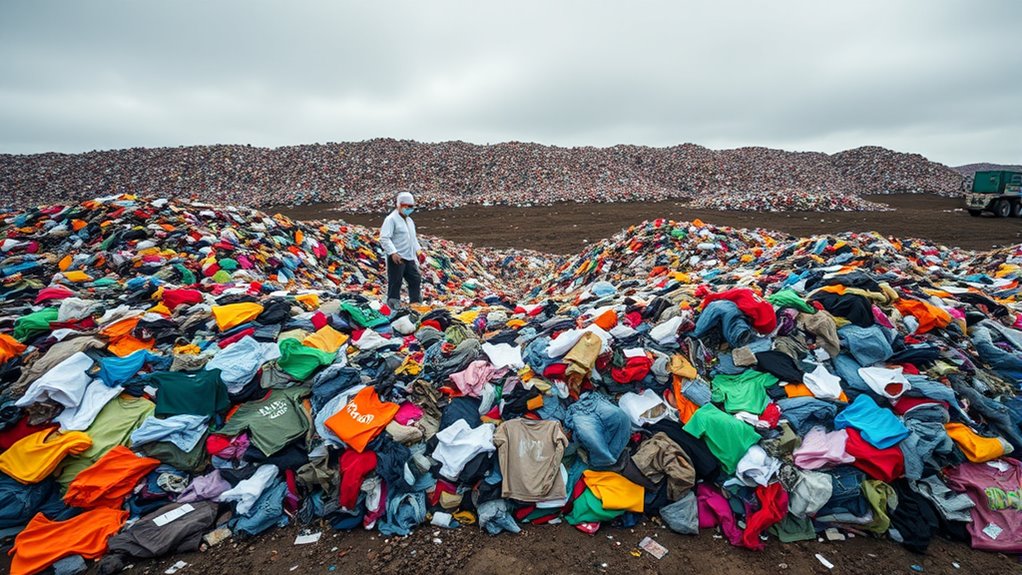
As the fashion industry struggles with its environmental impact, one pressing issue is the massive amount of waste generated by discarded clothing. Every year, millions of tons of textiles end up in landfills, taking decades to decompose. Fast fashion accelerates this problem, encouraging frequent purchases and quick disposal. Landfills overflow with clothing that often contains synthetic fibers, which release harmful microplastics into the environment as they break down. You might not realize that your discarded garments contribute to this crisis, polluting soil and water sources. This waste not only wastes resources invested in production but also releases greenhouse gases as textiles decompose. Incorporating natural materials into your wardrobe can help reduce synthetic waste and lessen environmental harm. Understanding production quantity variance and other cost management strategies in the fashion supply chain can also promote more sustainable manufacturing practices. Additionally, supporting brands committed to sustainable sourcing can significantly reduce the ecological footprint of your wardrobe. To make a difference, you can choose to donate, recycle, or buy second-hand, helping reduce the volume of clothing dumped in landfills.
The Role of Sustainable Materials in Reducing Environmental Harm

Switching to eco-friendly fabrics like organic cotton and hemp helps reduce chemical runoff and water use. Recycling textile waste turns old garments into new materials, cutting down on landfill overflow. Additionally, understanding the 16PF personality traits can help consumers make more conscious choices aligned with their values. Incorporating sound therapy techniques into fashion-related wellness initiatives can further promote sustainable lifestyles. Using sustainable fashion practices can also inspire industry change and consumer awareness. By choosing sustainable options, you can make a direct impact on lowering environmental harm caused by fashion.
Eco-Friendly Fabric Options
Wondering how fashion can become more sustainable? Choosing eco-friendly fabrics is a great start. Materials like organic cotton, hemp, and Tencel are made using fewer chemicals and less water, reducing their environmental impact. Recycled fabrics, such as polyester made from plastic bottles, help divert waste from landfills. Bamboo fabric, if sourced responsibly, grows quickly and requires minimal resources. These options not only lessen pollution but also lower carbon emissions compared to conventional textiles. When shopping, look for labels that specify sustainable practices. Incorporating sustainable textiles into your clothing choices can significantly lessen the fashion industry’s environmental footprint. Additionally, selecting fabrics produced with low-impact manufacturing methods further reduces environmental harm. Choosing fabrics that are certified for their environmental sustainability ensures you support practices that prioritize ecological health. By selecting eco-friendly fabrics, you directly contribute to reducing the environmental footprint of your wardrobe. Making mindful choices about the materials you wear can create a more sustainable fashion industry and help protect our planet.
Organic Material Benefits
Choosing eco-friendly fabrics is a positive step toward sustainability, but understanding their benefits highlights why these materials matter. Organic fabrics, like cotton, hemp, and linen, are grown without synthetic pesticides or fertilizers, reducing chemical runoff and soil degradation. They require less water and energy during cultivation, decreasing their overall environmental footprint. These materials are biodegradable, meaning they break down naturally without releasing harmful toxins. By choosing organic, you support farming practices that protect biodiversity and promote healthier ecosystems. Additionally, organic fibers often avoid harmful dyes and chemicals, making them safer for both workers and consumers. Incorporating regenerative farming practices can further enhance the positive environmental impact of organic textiles. Moreover, selecting organic materials can encourage sustainable agriculture and promote long-term environmental health. Your choices directly contribute to reducing fashion’s environmental impact, fostering a greener future.
Recycling Textile Waste
Recycling textile waste plays a crucial role in reducing the environmental harm caused by the fashion industry. When you repurpose or recycle fabrics, you cut down on landfill waste and lessen the demand for new raw materials. This process saves energy and reduces pollution associated with textile production. By choosing brands that prioritize recycling, you support sustainable practices. Additionally, recycling can turn old garments into new textiles, extending their lifecycle and decreasing waste. Below is a simple comparison:
| Traditional Textile Production | Recycling Textile Waste |
|---|---|
| Uses virgin resources | Reuses existing materials |
| High energy consumption | Lower energy use |
| Generates more waste | Minimizes landfill waste |
| Environmental impact increases | Environmental impact reduces |
Ethical Labor Practices and Eco-Conscious Brands

You can support brands that prioritize fair wages and safe working conditions, ensuring workers are treated ethically. These brands often align with sustainable values and are transparent about their sourcing practices. Choosing such companies helps promote a more ethical and eco-conscious fashion industry.
Fair Wages and Conditions
While many fashion brands promote sustainability, not all prioritize fair wages and safe working conditions. As a conscious consumer, you can support brands that ensure workers are paid fairly and work in safe environments. These companies often cooperate with ethical factories, enforce strict labor standards, and are transparent about their supply chains. By choosing brands committed to fair wages, you help reduce exploitation and improve workers’ quality of life. Safe working conditions also prevent accidents and health hazards, creating a more humane industry. Your purchases can drive change by encouraging brands to adopt ethical labor practices. Look for certifications like Fair Trade or WRAP, and research brands’ labor policies. Your choices have the power to promote fairness, dignity, and safety in the fashion industry.
Sustainable Brand Values
Have you ever considered what a brand’s true values say about its commitment to sustainability? When choosing eco-conscious brands, look for those that prioritize ethical labor practices and environmental responsibility. Such brands often align their values with fair wages, safe working conditions, and sustainable materials. To help you identify these brands, consider the following:
| Ethical Commitment | Eco-Friendly Practices | Transparency |
|---|---|---|
| Fair wages | Recycled fabrics | Clear sourcing info |
| Safe workplaces | Low-impact dyes | Ethical certifications |
| Worker rights | Reduced waste | Honest marketing |
Transparency in Sourcing
Understanding a brand’s true commitment to sustainability goes beyond surface-level claims; transparency in sourcing reveals how ethically and environmentally responsible a company genuinely is. When you look into a brand’s sourcing practices, you can see if they prioritize fair wages, safe working conditions, and eco-friendly materials. Brands that are open about their supply chains allow you to verify their claims and hold them accountable. This transparency helps you make informed choices, supporting companies that align with your values. By choosing brands committed to ethical labor practices and eco-conscious sourcing, you contribute to reducing environmental harm and promoting fair treatment for workers. Ultimately, transparency in sourcing empowers you to support sustainable fashion that genuinely cares for people and the planet.
How Consumers Can Make Eco-Friendly Fashion Choices

You can make a considerable impact by choosing eco-friendly fashion options. Start by opting for brands that prioritize sustainable materials like organic cotton, hemp, or recycled fabrics. Look for certifications such as Fair Trade or GOTS to guarantee ethical practices. Consider buying fewer, high-quality pieces that last longer, reducing waste and minimizing your environmental footprint. Embrace secondhand shopping or clothing swaps to extend the life of garments and avoid fast fashion. When purchasing new, ask questions about how items are made and where materials come from. Properly caring for your clothes, like washing in cold water and air-drying, also helps reduce environmental harm. Small choices add up, so being mindful in your shopping habits can notably contribute to a more sustainable fashion industry.
Innovative Technologies Transforming Sustainable Fashion

Innovative technologies are revolutionizing sustainable fashion by making production processes more eco-friendly and efficient. You can now see how advancements are reducing waste, conserving resources, and lowering pollution. For example, 3D printing minimizes material waste by creating precise designs, while bio-fabrication uses lab-grown fibers instead of traditional textiles. Digital solutions like blockchain improve transparency, ensuring ethical sourcing. Waterless dyeing techniques cut water consumption remarkably. Innovations in recycling enable fabrics to be repurposed, reducing landfill waste. These technologies help you enjoy stylish, eco-conscious fashion without sacrificing quality or trendiness. By embracing these breakthroughs, you contribute to a more sustainable industry and help lessen fashion’s environmental footprint. The future of fashion is innovative, conscious, and tech-driven.
Practical Tips for Building a More Sustainable Wardrobe

Creating a more sustainable wardrobe starts with making intentional choices about the clothing you buy and keep. Start by prioritizing quality over quantity—invest in timeless pieces that last longer rather than fast fashion items that quickly wear out. Before purchasing, ask yourself if you really need it, and consider whether it’s made from eco-friendly materials. Opt for secondhand stores or clothing swaps to extend the life of garments and reduce waste. Take good care of your clothes by following washing instructions and repairing items when needed. Finally, donate or recycle clothes you no longer wear instead of throwing them away. Small, mindful steps like these can notably reduce your fashion footprint and promote a more sustainable wardrobe.
Frequently Asked Questions
How Does Fast Fashion Contribute to Global Carbon Emissions?
Fast fashion considerably boosts global carbon emissions because your quick turnover of cheap, trendy clothes encourages mass production. When you buy these garments, factories use fossil fuels for manufacturing, transportation, and distribution, releasing greenhouse gases. Additionally, discarded fast fashion items often end up in landfills, where they emit methane. By purchasing less and choosing sustainable options, you can help reduce your carbon footprint and lessen the environmental impact of fashion.
What Are the Most Sustainable Materials Currently Available?
You’re wondering about sustainable materials. You should look for options like organic cotton, which uses fewer chemicals, and Tencel, made from eucalyptus trees that need less water. Recycled polyester is another good choice, repurposing plastic bottles. Hemp and linen are natural fibers that grow quickly with minimal resources. Choosing these materials helps reduce environmental impact, making your fashion choices more eco-friendly and supporting sustainable practices.
How Can Consumers Identify Genuinely Eco-Friendly Brands?
You might think all eco-friendly brands are transparent, but that’s not always true. To spot genuinely green brands, look for certifications like GOTS or Fair Trade, and read their sustainability reports. Check their sourcing practices and whether they prioritize ethical manufacturing. Trust brands that openly share their supply chain details and demonstrate consistent eco-friendly efforts. Your vigilance helps guarantee you support truly sustainable fashion, making a positive impact with every purchase.
What Policies Can Governments Implement to Promote Sustainable Fashion?
You can advocate for governments to implement policies that promote sustainable fashion. Push for regulations requiring transparency in supply chains, incentives for eco-friendly practices, and stricter environmental standards. Support initiatives that fund sustainable textile research and enforce eco-labeling. By encouraging policymakers to prioritize green standards, you help create a market that favors responsible brands, making it easier for you to choose environmentally conscious fashion options and reduce overall environmental impact.
Are There Affordable Options for Sustainable Clothing?
Affordable sustainable clothing might seem like a paradox, but it’s definitely possible. You can find budget-friendly options by shopping secondhand, participating in clothing swaps, or choosing brands that prioritize ethical practices without high price tags. Thrift stores and online marketplaces often offer stylish, eco-friendly pieces at a fraction of the cost. By being mindful and resourceful, you can enjoy fashion that’s both affordable and better for the planet.
Conclusion
By choosing eco-friendly brands and investing in quality pieces, you can markedly reduce fashion’s environmental impact. Imagine swapping fast fashion for a timeless, sustainably-made jacket—like Patagonia’s commitment to repair and recycle. Your small, conscious choices add up, helping protect our planet. Every purchase matters, so start building a wardrobe that’s stylish, durable, and kind to Earth. Together, we can make fashion more sustainable for future generations.
